
Hyundai i30 Hatch 2021 review
The i30 hatch is an Aussie favourite and there are plenty of good reasons for that title.
Browse over 9,000 car reviews
Since its inception, the Volkswagen Golf has been the 'people's car' at the heart of the VW brand.
To be handed the keys to a new generation version for a launch review is somewhat momentous. Historic, even. But I can't help but feel like it comes at the beginning of the legendary nameplate's twilight phase.
Eight generations in, with a rich history stretching from a populous economy hatch to wild track-focused variants, it's starting to become apparent the writing is on the wall for the single car that has been emblematic of the German brand for the last 45 years.
It's not just that the point of focus for buyers has shifted away from hatchbacks, towards SUVs (like the Tiguan), but also the impending era of electrification which should see models like the all-electric (and supposedly affordable) ID.3 ultimately replace combustion cars like the Golf. A thought which was, even a year or two ago, almost unthinkable.
So, in what could be the last or second-last hurrah for the car that replaced the Beetle, at a momentous turning point in history toward electrification and SUVs, what does the Golf 8 have to offer?
I took what should be its most popular variant, a mid-grade 110 TSI Life at its Australian launch to find out.
| Volkswagen Golf 2021: 110 TSI Life | |
|---|---|
| Safety rating | |
| Engine Type | 1.4L turbo |
| Fuel Type | Premium Unleaded Petrol |
| Fuel Efficiency | 5.8L/100km |
| Seating | 5 seats |
| Price from | $29,920 |
On the face of it, the new-generation Golf has had a major price hike, especially for the entry-level grade.
Peer at the equipment list, however, and it's clear to see there's a statement being made here. Even the base car, now simply called 'Golf', is beyond fully loaded when it comes to equipment. VW says it could have made the car cheaper, but that's not where its buyer is.
In fact, the brand says by the time this car's 7.5 predecessor was headed to the grave, the average consumer was bringing the price of even a 110 TSI Comfortline to $35K-plus, indicating a healthy appetite for options.
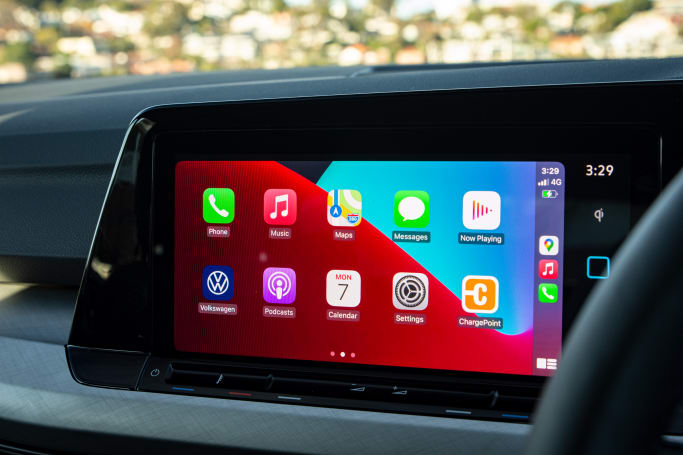
For this new one VW has made it simple by just including almost everything that would have once been an option as standard.
It kicks off with the base Golf, which incredibly can still be chosen with a six-speed manual ($29,350 MSRP) or a new eight-speed Aisin-sourced automatic ($31,950).
This entry-level version scores an impressive all-digital cabin, comprising a 10.25-inch digital instrument cluster, an 8.25-inch multimedia touchscreen with wired USB-C Apple CarPlay and Android Auto connectivity and voice commands, LED exterior lights, 16-inch alloy wheels, tri-zone climate control, a six-speaker stereo, auto dimming rear vision mirror, push-start ignition, shift-by wire interior controls, a tyre pressure indicator, and cloth seat trim with manually adjustable seats.
That's a lot of stuff, but where the base Golf really gets ahead are amazing inclusions like tri-zone climate, full LED lighting, and digital cockpit.

Next up is the Life (auto only - $34,250) which upgrades the digital dash suite to the 'pro' version including further customisation options and built-in navigation, upgrades the media suite to a 10.0-inch unit with wireless Apple CarPlay, Android Auto, and device charging, 17-inch alloy wheels, decorative trim upgrades, premium cloth seats with lumber adjust, an LED ambient lighting package, and auto folding exterior mirrors.
Topping off the 'regular' Golf range is the R-Line (auto only - $37,450). As its name suggests this variant adds a sportier bodykit with 18-inch alloys, sporty interior trim touches and unique seats, rear window tint, upgraded LED headlights with auto high beams, and a sportier steering wheel with touch panel controls.
Finally, the range is topped off with the GTI ($53,100) which has a larger 2.0-litre turbo engine and carryover seven-speed dual clutch automatic, front differential lock and sporty dual-exhaust, 18-inch alloy wheels with unique bumper and spoiler designs, and various performance upgrades and interior trim treatments.
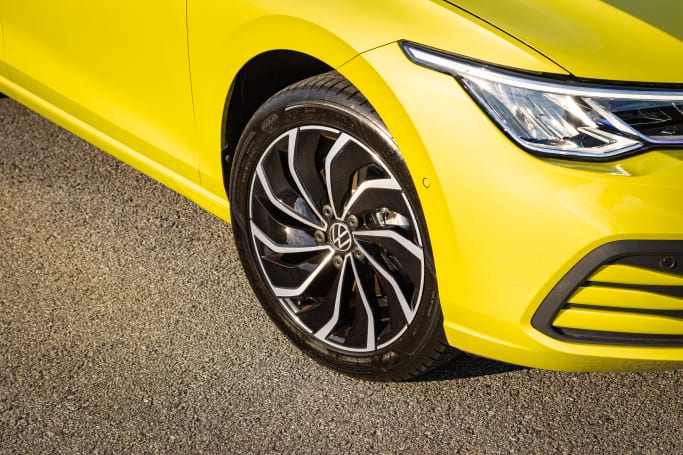
Option packs in the Golf 8 range include the Sound & Vision package' for the Life, R-Line, and GTI ($1500) which includes a premium Harmon Kardon audio system and holographic head-up display. The 'Comfort and Style package' ($2000) for the Life only includes 30-colour interior ambient lighting, sports seats, and a panoramic sunroof.
Finally, the 'Luxury package' for the GTI ($3800) includes heated and cooled front seats, electric adjust for the driver's seat, partial leather trim, and a panoramic sunroof. The panoramic sunroof can be fitted to the R-Line separately for $1800.
For some buyers who are apparently in the minority, it is alarming that the Golf now starts up around $30,000 and not in the mid-twenties like base versions of the Hyundai i30 (auto $25,420), Toyota Corolla (Ascent Sport manual - $23,895), and Mazda 3 (G20 Evolve manual - $26,940), although VW points out that there are numerous other benefits to the base Golf beyond its standard equipment, like its Euro6 complaint 1.4-litre turbo engine, low fuel consumption, and driver-focused independent rear suspension.
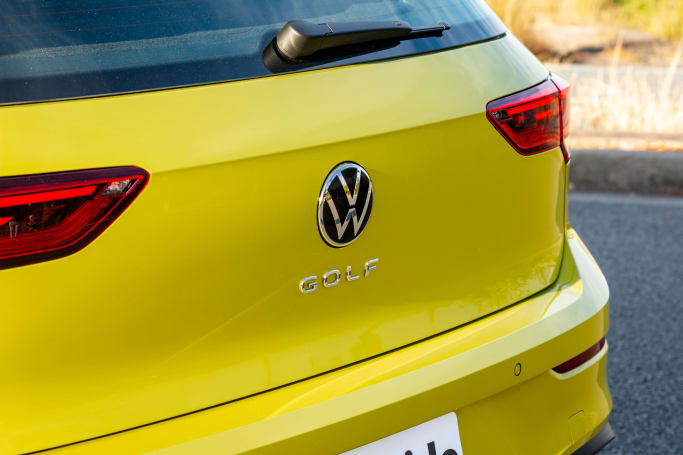
Like other recently updated Volkswagen products, the new Golf also includes the brand's full 'IQ Drive' safety suite as standard. Read more about this over in the safety section of this review. The Golf range also spans to include the GTI hot hatch – not a feature of the Mazda3 or Corolla range – but frustratingly (for buyers and VW Australia) there's no hybrid variant.
This is because the brand's hybrid-ready 1.5-litre 'evo' engine remains incompatible with Australia's high-sulphur fuel. More on this in the engine and transmission section of this review, and if you're interested, make sure to take a look at our news coverage of this topic, too.

From the outside there's no mistaking the Golf. This is partially because this car's conservative and sensible visage has become synonymous with the brand, but also because the updates to the Golf 8's look could easily be mistaken for a simple facelift over the 7.5 it replaces.
It's certainly a story of evolution rather than revolution, with the side profile of the new Golf being near identical to its predecessor.
The face is the most heavily tweaked feature from the outside, with a tidy new bumper and notable lack of a discernible grille or intake, alluding to this car's tweaked efficiency.
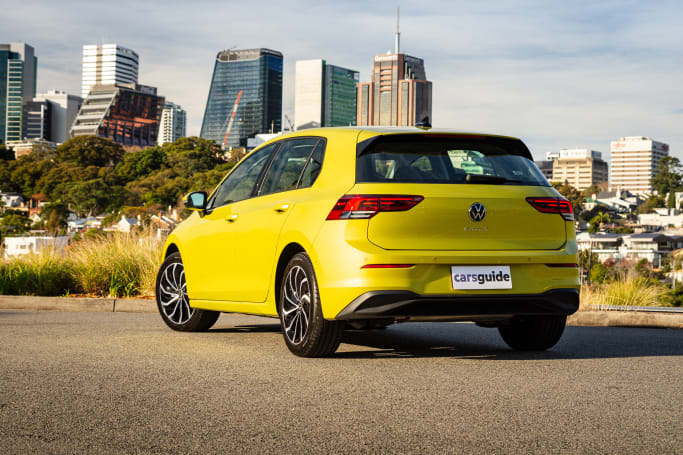
The paint colour now also spills into highlight strips in the lower bumper, and the LED light fittings and tidy two-tone alloys complete a slightly more upmarket look to go with the increased price-tags.
It's neat as ever, exactly what a lot of Golf buyers will be searching for, but it will be hard to impress your neighbour if you're replacing new for old.
That is, until you get them on the inside. This is where the 'new-generation' part of the car comes into play. The 7.5's conservative interior has been dumped in favour of something far more contemporary and tech heavy.
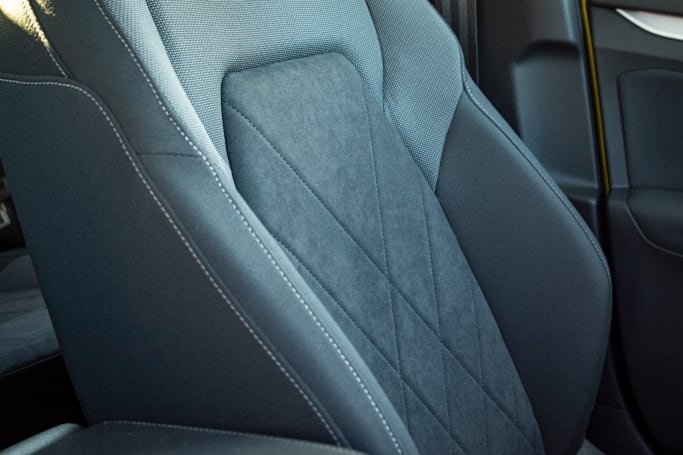
The big screens with sleek software, set in a gloss highlight bar across the dash is something to behold in such a compact car, and the slick shift-by wire controls combine with subtle ventilation fittings and typically Teutonic VW switchgear to make for a cabin that is familiar yet futuristic.
The brightness and colour of the panels makes them pop without being overbearing, while the matte silver strip running across the dash and into the doors adds enough of a highlight piece to prevent the interior from being one big slate of grey – usually one of my main VW interior complaints.
It's all fitted and finished beautifully, with lots of little texture work on the storage areas, and I couldn't help but smile when I realised the piped seat trim in our mid-grade Life test car is actually a 'VW' pattern. It's attention to detail like that which can really make or break an interior, and it's nice to see it hasn't been forgotten in such a mainstream model.
On that topic, the GTI will of course maintain its perforated and flat-bottomed sporty steering wheel and cloth seat trim finished in a tartan pattern. It's a little sad that the lack of a manual variant for the stalwart hot hatch means no golf ball shifter, once famously cited as evidence that Germans do, in fact, have a sense of humour.
The Golf has always had a smart cabin and excellent ergonomics, and this continues in the eighth generation.
Like the interior's overall look, the seating position for the driver is both familiar and improved. The steering wheel is an evolution of the Golf 7.5's, a three-spoke design which has been chiselled into a slightly new shape, with the new logo and satisfyingly clicky function buttons.
This is good for people who don't like touch interfaces, as, unfortunately, the new Golf is devoid of any rotating dials. Rotating light selector? Replaced by touch panels. Volume knobs? Replaced by touch sliders. Even the climate controls have been rolled into the multimedia suite, in a great loss for driver-friendly adjustment.
Thankfully, the Golf 8's completely new software suite is stellar, and even in the base car you can adjust these functions with voice controls, but it's never a good day for drivers when proper tactile dials move from the dash to the bin.
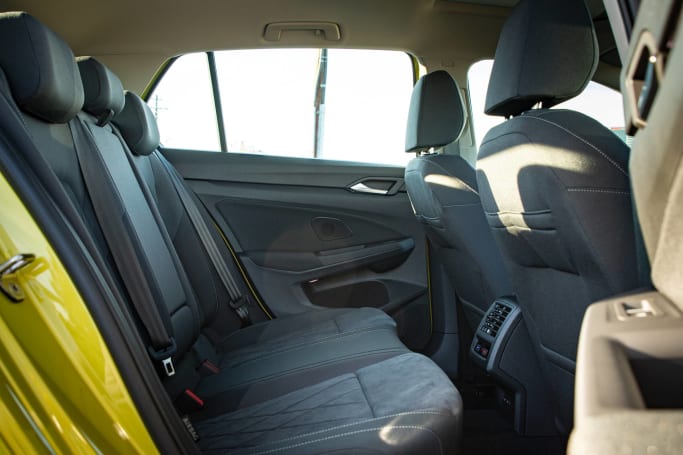
On the topic of software, Volkswagen Group's digital dash system is by far the best on the market, with an astoundingly sharp and clear panel, seemingly not subject to glare or other inconveniences. The hardware grunt behind both screens is evident, too, as they feature lightning-fast reaction times and smooth frame rates, making both panels a pleasure to use.
The driver's seating position can be nice and low offering a sporty feel, but also great adjustability for front occupants (even if it is manual on most variants). There are huge bottle holders and storage bays in the doors, as well as a large tray where the climate unit used to be and a large bay which features a fold-out cupholder divider in the centre console. There is also a large armrest box with adjustable heights.
You'll want to bring a converter with you in the base car as all USB ports are of the new C variety, although they're seemingly unnecessary for solo travellers in the Life, R-Line, and GTI grades which come standard with a wireless charging bay and phone connectivity.
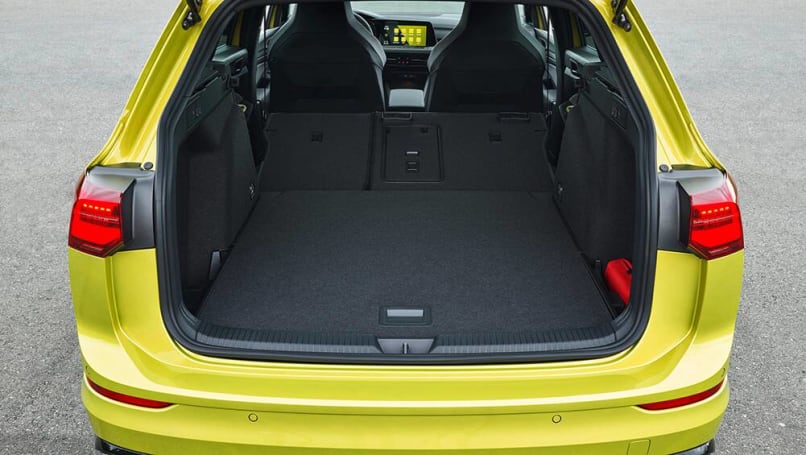
The rear seat is the new benchmark for the mid-size hatchback segment. Not only do entry level versions feature their own climate zone with controls and adjustable air vents, but there are also dual USB-C outlets, a selection of three pockets on the backs of the front seats in the Life grade up, large bottle holders in the doors, and a drop-down armrest with dual bottle holders, too.
In every grade the excellent seat trim and low-slung seating position continues to the rear, and I fit behind my own driving position with plenty of airspace for my knees at 182cm (6'0") tall.
Boot space has always been decent in the Golf, and this continues in the eighth-gen car, with 374-litres (VDA) on offer, enough to consume our three-piece demo luggage set. This space can expand to 1230L with the rear seats folded down. A space saver spare lives under the floor on all standard Golf variants.
There's some great news and some less good news here. We'll get the less good out of the way first: Despite this being a 'new-generation' car it continues with carryover engines across the whole range as well as a distinct lack of hybrid options.
This is not entirely uncommon in Australia, with Hyundai's new Tucson SUV another recent example of this happening, but it's still disappointing.
Over in Europe the Golf is fitted with a new 1.5-litre 'evo' engine which is essentially the next step for the 110TSI engine which features across the Australian range, although the European-market version opens the door to further electrification and efficiency.
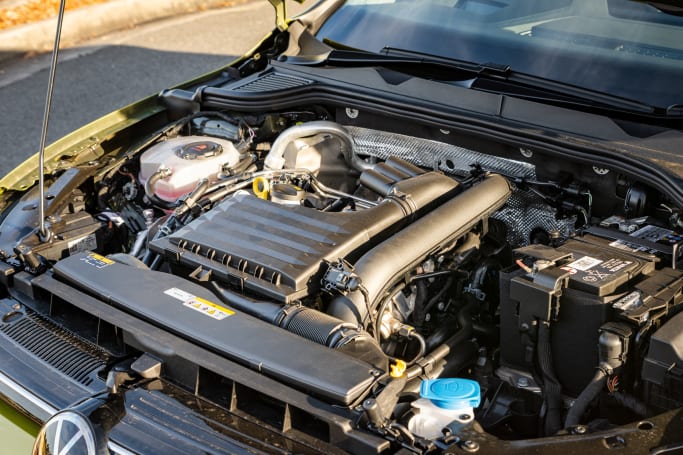
In good news, though, this means the Golf which arrives in Australia dumps the seven-speed dual-clutch auto the brand is known for in favour of an Aisin-sourced eight-speed torque converter automatic. Make no mistake, this is very good for drivers. We'll look at why in the driving section of this review.
The standard Golf range, from the base car to the R-Line, carries over a familiar '110 TSI' 110kW/250Nm turbocharged 1.4-litre four-cylinder petrol engine, while the GTI maintains its well-regarded (EA888) 2.0-litre four-cylinder turbo which produces 180kW/370Nm paired to a seven-speed dual clutch auto.
All Golf variants with their small capacity turbo engines require mid-grade 95RON but have impressive fuel consumption figures to hopefully make up for it when it comes to the back pocket.
The 110 TSI Life as tested for this range review shares a claimed/combined fuel consumption figure with the rest of the eight-speed automatic range of 5.8L/100km which is astoundingly low for a non-hybrid. Our real-world test produced a more realistic figure of 8.3L/100km, perhaps speaking to the lesser efficiency of the eight-speed auto compared to a dual-clutch, although there's little doubt lower figures can be obtained over time.
The base manual will apparently score even lower than the auto at 5.3L/100km, although we haven't tested this car yet.
Meanwhile, the go-fast GTI has a claimed combined cycle consumption figure of 7.0L/100km. Stay tuned for our variant review shortly, for our as-tested number. All Golf hatch variants have a 50L fuel tank.
A big selling point of the new Golf is its thoroughly upgraded safety suite which is standard across the whole range.
This includes freeway speed auto emergency braking (AEB) with pedestrian and cyclist detection, lane keep assist with lane departure warning, blind spot monitoring with rear cross-traffic alert, safe exit warning, adaptive cruise control with stop and go function, and a new emergency assist function.
Like most VW Group products, the Golf also features the 'proactive passenger protection system' which pre-tightens seatbelts, cracks open the windows slightly for optimal airbag deployment, and applies the brakes when it detects the possibility of a collision.
This time around the Golf has been augmented to include eight airbags, and the standard array of traction and stability controls are present alongside ISOFIX child seat mounting points on the outboard rear seats, and top-tether mounts across the rear row.
Unsurprisingly with all that kit, the Golf 8 range carries a maximum five-star ANCAP safety rating to the 2019 standards.
Basic Warranty
5 years / unlimited km warranty
ANCAP Safety Rating

The Golf range maintains the brand's five year and unlimited kilometre warranty promise with roadside assist. This is competitive with its key rivals, although it doesn't move the envelope forward. A nice addition is the VW 'Care Plans' which allow you to pre-pay for servicing in advance (and bundle it in on finance if you wish).
A three-year plan costs $1200 for the 1.4-litre models, or $1400 for the 2.0-litre GTI, while a five-year plan costs $2100 for 1.4-litre cars or $2450 for the GTI.
If the five-year plan is selected this means an average cost of $420 per year for the life of the warranty for the main range, or $490 per year for the GTI. Not the most affordable we've seen, particularly against rivals with older engines, but not bad considering VW's higher-tech drivetrains.
The Golf 7.5 was a real gem to drive, standing generally above its peers when it came to ride and handling, the big question I had for number eight was: How could VW possibly do better?
The answer for 110 TSI variants is simpler than you might think. Dumping the dual-clutch automatic in favour of the very-well regarded Aisin eight-speed auto, which also appears (and shines) in many other cars, is a key move which makes the Golf delivered in Australia ultra-consumer friendly.
I had no idea, for example, that the 1.4-litre turbo 110 TSI engine was this good. I always had a feeling it was held back by the jerkiness and hesitancy of the dual-clutch automatic with which it is always paired, but with a torque converter automatic the way this combination plays makes it easily the best Golf in years.
The transmission locks into each gear instantaneously, intelligently switches between the correct ratios in the corners and on hills, and overall improves the drive experience out of sight. It's not as lightning fast to swap cogs on the straight, nor does it seem to be quite as fuel efficient, but the trade-off for daily drivers in low-speed traffic is an obvious one.
Suffice it to say, if you've owned a 110 TSI Golf before, you'll love this one. The other areas of the drive experience are largely the same, or even refined further from the previous car. This car's underpinnings have been slightly re-worked to further tune the suspension, which is as well set up and effortless as ever.
It's really at the top of the segment for ride and road holding, especially given its independent rear suspension as opposed to the torsion beam in more basic rivals. This is a difference you can really feel, with the Golf proving settled over bumps, potholes, and corrugations, despite a firm low-roll set in the corners.
And this is all in a non-performance variant. I'd say the only non-VW Group car that comes close at this price is the Toyota Corolla. The Mazda3 and Hyundai i30, while great for the segment, don't quite strike the balance between sporty and comfortable as well with their torsion bar rear.
The future-focused feel of the cabin leaves its impression on the driver, too. While I've complained about the touch panel climate controls, the Golf has a new 'smart' climate screen where you can use basic functions set to a default 20.5 degrees with a single touch.
The holographic head-up display sits almost in the middle of your line of sight (even with adjustment) which was initially odd, but its opacity is so low that it doesn't interfere with your view of the road, and I found myself glancing at the actual dash less and less the more I drove it. It's more intuitive than you might initially give it credit for.
This is usually the part where I introduce you to some negative drive qualities, but aside from my preference for tactile controls there's so little to complain about here, especially with that new transmission. I had expected the adaptive cruise to be a little more assistive on the steering like Mercedes-Benz products, maybe, but that's the only other thing that comes to mind.
The Golf 8 proves it's not enough to just maintain a position as the benchmark for driving in the hatch segment, but to continually move it forward. I pity my European colleagues who won't get to experience this version of the car with a far more driver-friendly automatic. I fear this flash-in-the-pan moment for this car will pass when the 1.5-litre evo engine arrives with a dual-clutch auto, re-introducing its characteristics, likely for the 8.5 facelift.
This version of the Golf then, could be the very peak for everyday drivers, at least as a combustion-only car. Historic indeed.
At this moment in history, as consumers shift to SUVs and electrification, the combustion-only Golf 8 range proves Volkswagen means to make the most of its legendary nameplates before their time comes.
It's true, there are some relatively minor changes here when it comes to the engine, platform, and even styling, but the Golf's tech-heavy cabin, expansive range, and ultra-refined driving characteristics allow it to well and truly assert its position as the benchmark of the hatch segment.
The base car is appealing, but the Life is where the full experience is, and it's our pick of the range.
| Vehicle | Specs | Price* | |
|---|---|---|---|
| Alltrack 132 TSI Premium | 1.8L, PULP, 6 SP | $36,080 – 42,900 | 2021 Volkswagen Golf 2021 Alltrack 132 TSI Premium Pricing and Specs |
| Alltrack 132 TSI | 1.8L, PULP, 6 SP | $31,790 – 38,280 | 2021 Volkswagen Golf 2021 Alltrack 132 TSI Pricing and Specs |
| R | 2.0L, PULP, 7 SP AUTO | $53,240 – 61,160 | 2021 Volkswagen Golf 2021 R Pricing and Specs |
| R | 2.0L, PULP, 7 SP AUTO | $51,370 – 59,070 | 2021 Volkswagen Golf 2021 R Pricing and Specs |
| Price and features | 8 |
|---|---|
| Design | 8 |
| Practicality | 8 |
| Under the bonnet | 8 |
| Efficiency | 8 |
| Safety | 9 |
| Ownership | 8 |
| Driving | 9 |
$24,990
Lowest price, based on 56 car listings in the last 6 months